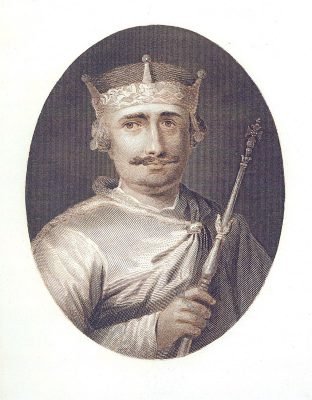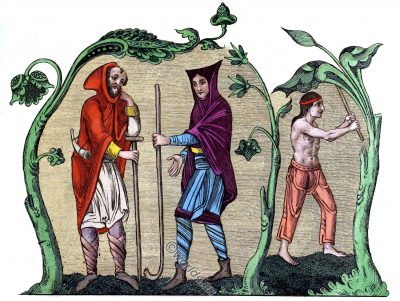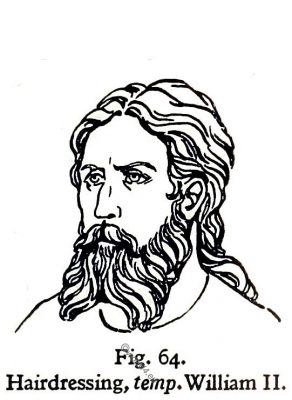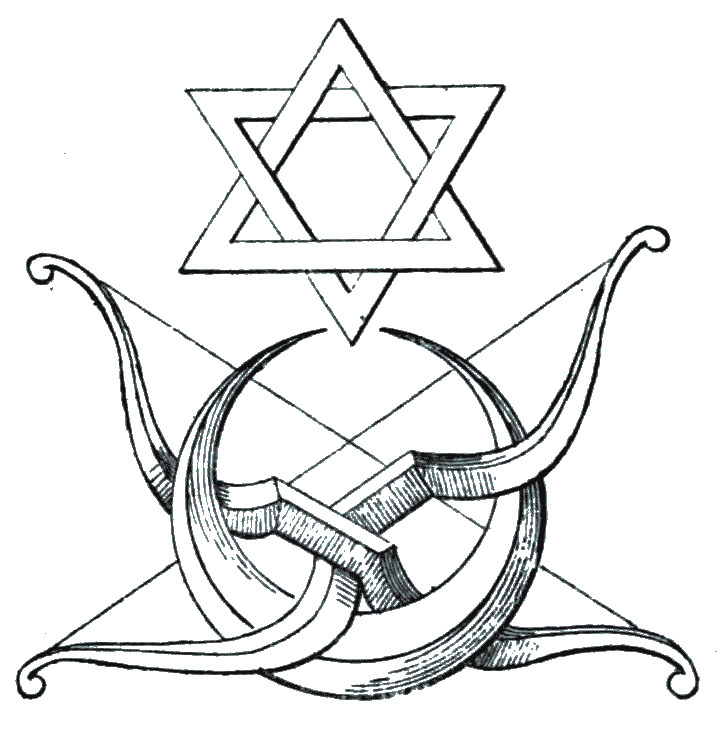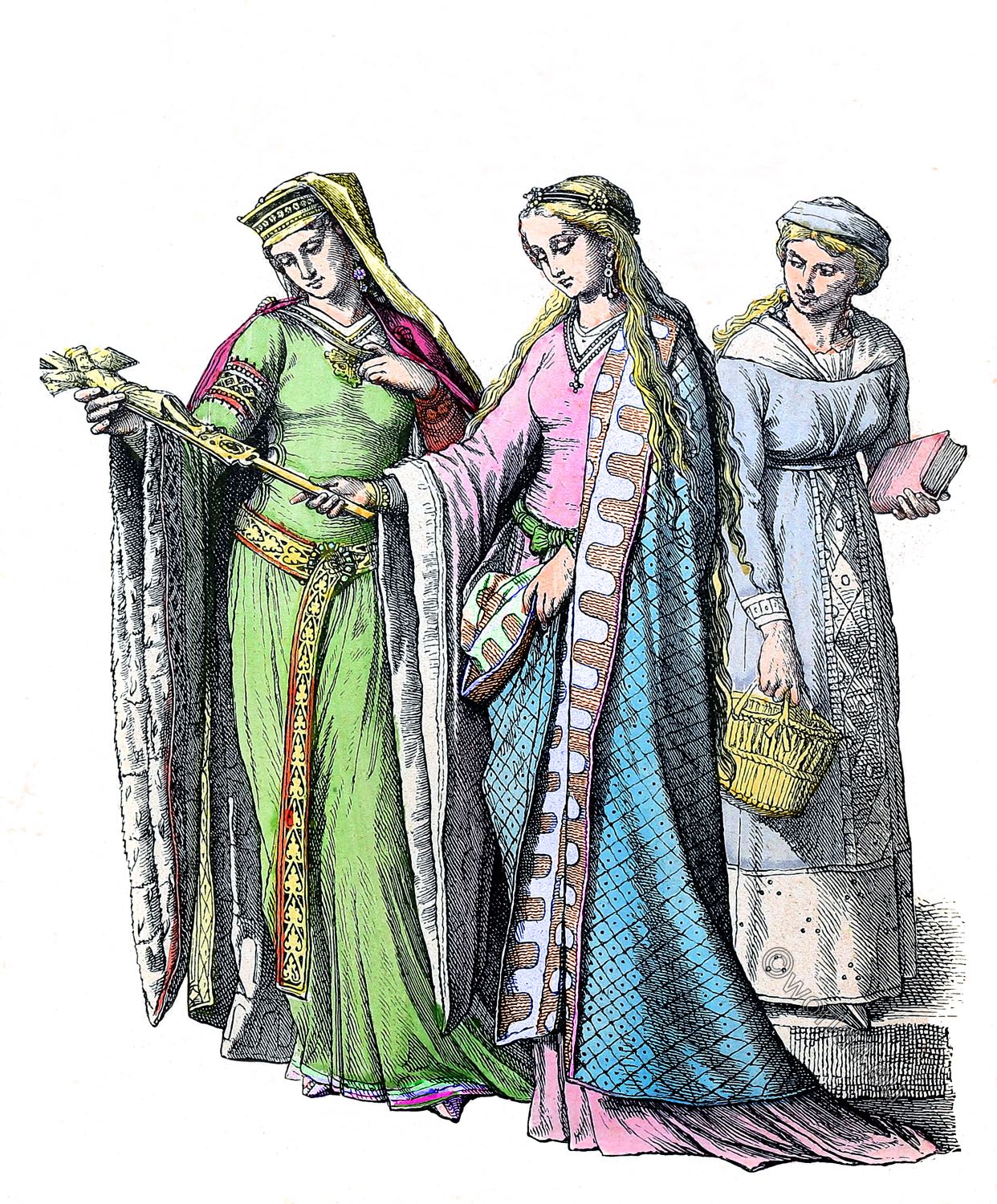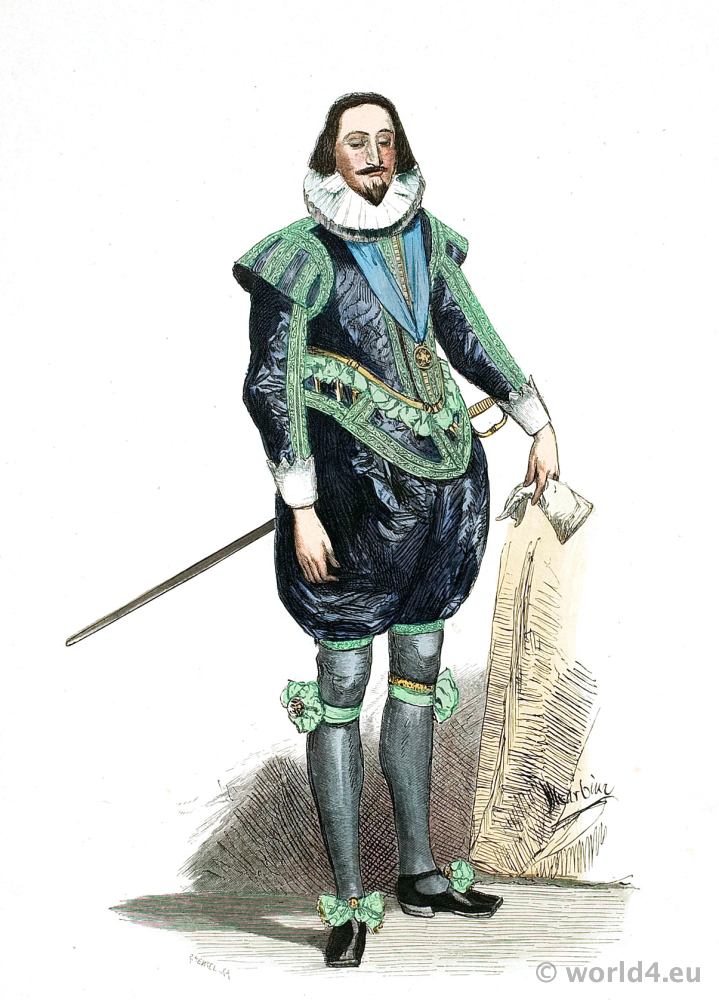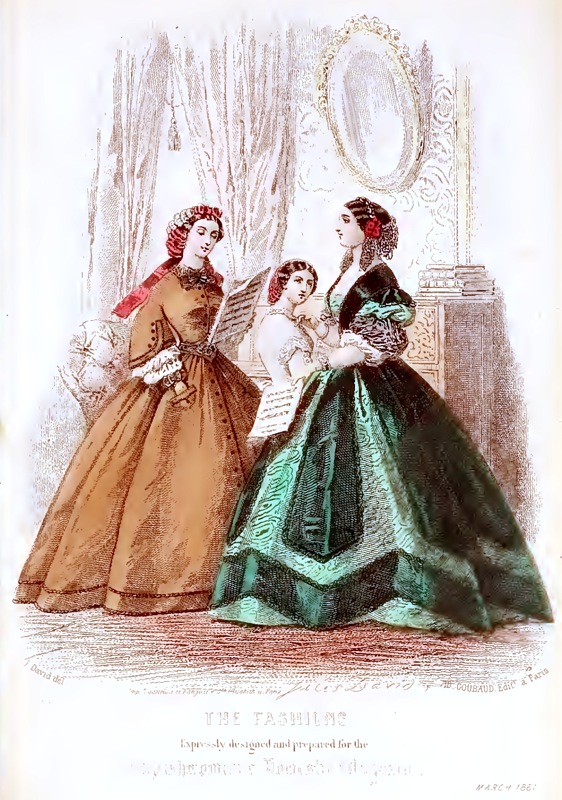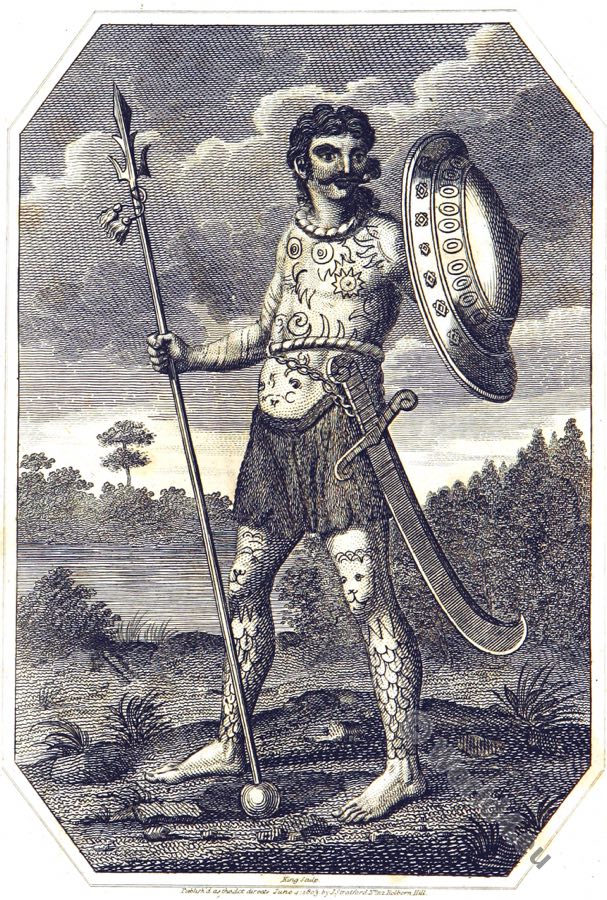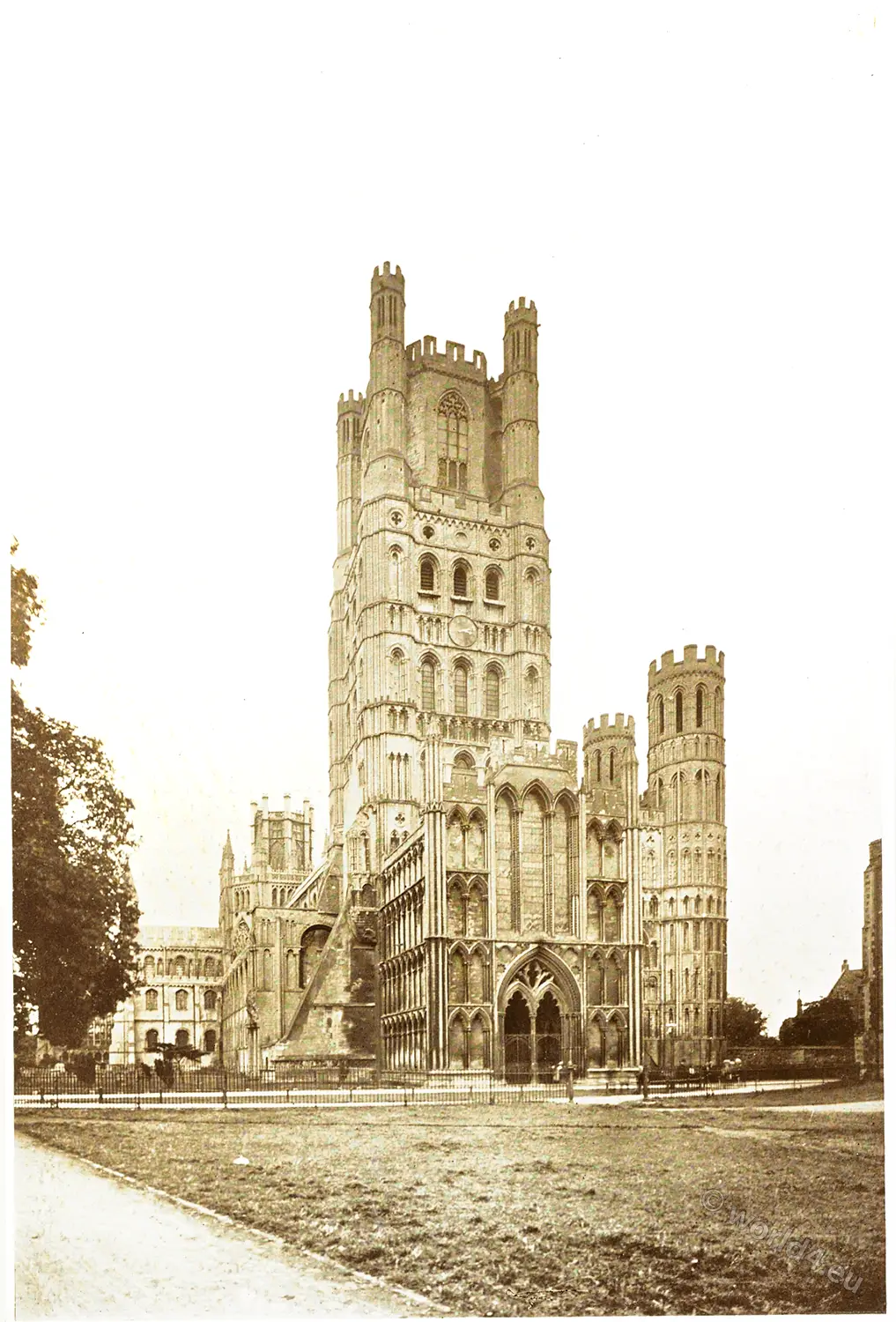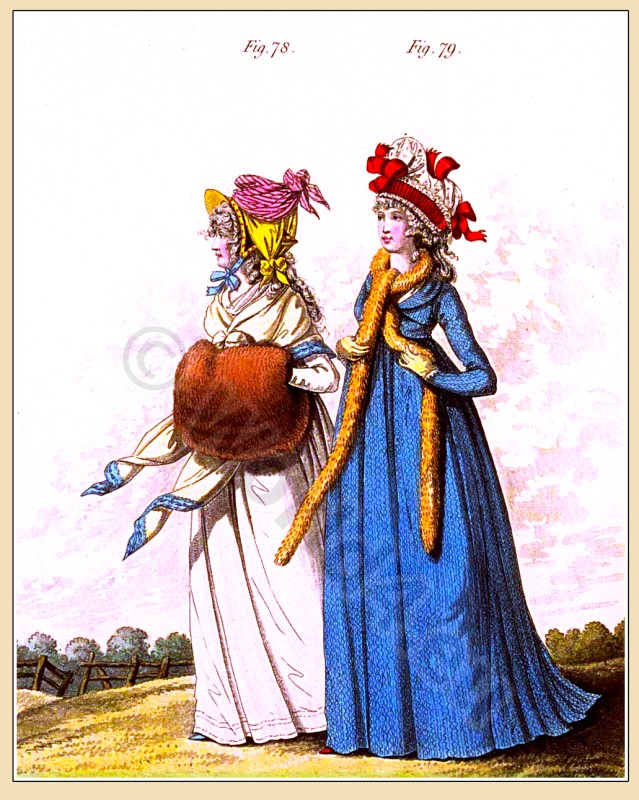Reign of William II. 1087-1100.
William II, called William Rufus, French Guillaume II, called Guillaume le Roux (c. 1051 – 3 February 1134), near Lyndhurst in Hampshire), was King of England from 1087 to 1100. The nickname Rufus means “with the red hair” or “with the red cheeks”. He was the son of Wilhelm the Conqueror and Mathilde, descended from the Kapetinger dynasty. On 26 September 1087 he was crowned in Westminster Abbey.
Nobility—Men
On the death of the Conqueror, Robert Curthose, his eldest son, succeeded to the Duchy of Normandy (1087-1134). He was incompetent and lazy, and his father had expressed a wish that England, newly conquered and hard to control, should be governed by his second son, William. There was as yet no settled rule of succession to the English crown, and William came immediately to England, seized the treasury at Winchester, and was crowned at Westminster by Lanfranc.
He began his reign well; the English, knowing his strength and their need of a king capable of controlling the turbulent Norman barons, rallied round him. When the barons rebelled for the first time, in favour of Robert, whom they knew to be too lazy to keep them in order, William crushed the rebels and banished their leader, his uncle Odo, Bishop of Bayeux. The Court of England’s first bachelor king was not graced by the presence of a royal lady to uphold its traditions or refinement.
William, called Rufus from the fact that his face was very red, was stout in figure, strong and big-limbed, with keen restless grey eyes under a broad high brow surmounted by light yellow hair. His voice was loud and he stammered, especially when angry. A faithful son, kind master and a brave knight, utterly fearless, nevertheless William took his share in the Court life of his time, which was passed in the foulest vice.
His quarrels with his brother Robert and with the Church, his war with the Scots, and his building operations, engrossed his attention too completely to leave time or inclination to create new fashions.
William II. met his death in the New Forest in 11OO by an arrow discharged by Walter Tirel, Lord of Poix, which is said to have been turned in its flight by glancing from the back of a hart. He was buried in Winchester Cathedral.

The nobility and upper classes had become wealthy by confiscation of the estates of the conquered English. Contemporary writers speak of this reign as being a period of great extravagance -not so much as regards new fashion as in the costly materials used for clothing, and also because of the practice of overloading the person with a superabundance of ornament.
Nobility, clergy and laity alike were condemned for their love of apparel and extravagance. At this time effeminacy was the prevailing vice throughout the world. Courtiers as well as wanton youths were sunk in it, and it was then the mode for young men to rival women in delicacy of person, to mince their gait, and walk with loose gesture. The English and French, and particularly the Normans under Duke Robert Curthose, are all censured for these failings.
The tunic was practically the only garment which underwent any change. It was worn longer and fuller than hitherto, extending from the neck to the feet, and hung in many folds. It had wide or close sleeves, and was girded or ungirded at the waist according to the wearer’s whim.
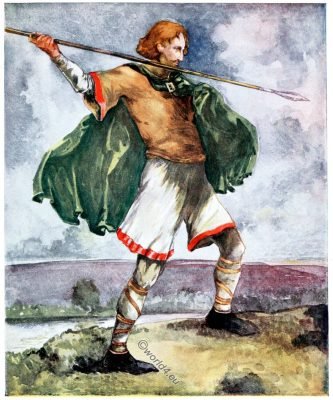
Clokes and mantles, of semicircular or rectangular cut, were made of very fine cloth, silk or other rich materials, lined with expensive furs- a new vogue. Legs were clothed, as previously, in braies, but the bestdressed men of the day realised that the closer fitting they were, the more becoming to a well-shaped leg.
Fig. 15 is constructed from an illumination in a MS. of this reign. It shows a noble wearing a long tunic, with wide sleeves embroidered at the edge, worn over an undertunic with close sleeves to the wrist. It should be noticed that the neckband is wider than in earlier examples, and more heavily ornamented.
This gentleman had evidently travelled in the East, and had adopted the pallium as worn in Constantinople. This one measures about twelve feet long by six wide, and is placed on the shoulder so that one-third of its length hangs on the wearer’s right. The remaining two-thirds hang to the left.
The top border of this portion is caught to the waist-belt on the right side, leaving one-third of it to be carried over the left arm. All round the pallium is an embroidered or woven border, its four corners being plainly shown in the drawing.
MIDDLE AND LOWER CLASSES
Men. Fig. 47 represents a citizen or yeoman, called a “vavasour,” at the end of the 11th century. This Welsh Knight man is wearing an outer tunic or cotte to the knee, slit up the sides.
The sleeves fit close to the arm, and are finished off at the wrist by a band stitched with a colour.
In the original picture this garment is shown brown. The sherte is made of coarse natural-hued hemp linen. The legs are clothed in braies or chausses, held close to the leg by means of braids or thongs of leather. On the shoulders a rectangular cloke is worn, with a corner pleated into a brooch and fastened on the right.
HAIRDRESSING
Temp. William II. 1087-11OO
By the time William II. ascended the throne of England in 1087, the English style of flowing locks and beards (Fig. 64) had become general throughout the whole country. This “effeminate” mode of hairdressing was not limited to England; in Normandy and France it was carried to such excess that in 1095 the Council of Rouen issued a decree forbidding the vogue, but without avail.
FOOTGEAR
Temp. William II. 1087-1100
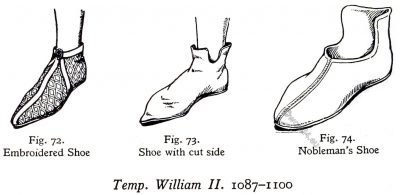
A nobleman’s shoe of this reign is shown in Fig. 74. It is cut very high at the back, sloping down towards and open on the instep. To make this kind of shoe fit well it was seamed up the centre, and over the seam a cord was sewn to ensure durability. This style remained in vogue for some time, and is shown in Figs. 78 and 80 under later dates.
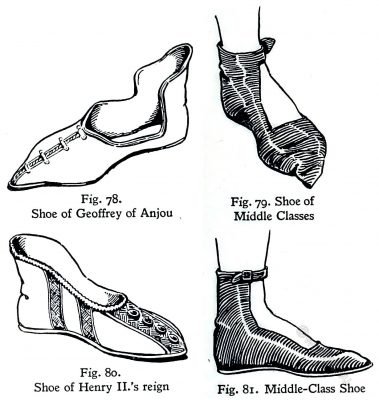
Source:
- Costume and Fashion. Volume Two. Senlac to Bosworth 1066-1485. By Herbert Norris. London and Toronto. J.M. Dent and Sons LTD. New York: E.P. Dutton and Co. 1927.
- A complete view of the dress and habits of the people of England by Joseph Strutt. London: H.G. Bohn, 1842.
- Lives of the queens of England, from the Norman conquest; comp. from official records and other authentic documents, private as well as public, by Agnes Strickland.
Continuing
Discover more from World4 Costume Culture History
Subscribe to get the latest posts sent to your email.


